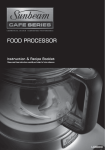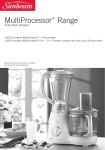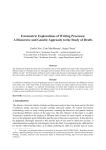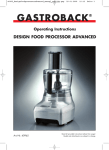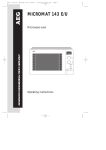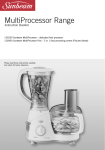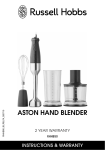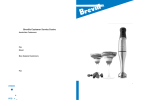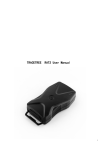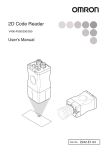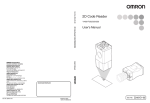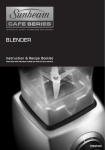Download Sunbeam LC7600 User's Manual
Transcript
Oskar™ Professional Direct drive food processor Instruction Booklet LC7600 Please read these instructions carefully and retain for future reference. Contents Sunbeam’s Safety Precautions 4 Features of Your Sunbeam Oskar™ Professional 6 Attachments for your Sunbeam Oskar™ Professional Using your Sunbeam Oskar™ 8 9 Professional 9 Fitting/using the tools on your Oskar™ Professional 11 Storing your Sunbeam Oskar™ Professional 13 Handy hints for Processing 15 Care and cleaning 17 Recipes 18 Important instructions – retain for future use. Sunbeam’s Safety Precautions • • • • • • • • Sunbeam are very safety conscious when designing and manufacturing consumer products, but it is essential that the product user also exercise care when using an electrical appliance. Listed below are precautions which are essential for the safe use of an electrical appliance: Read carefully and save all the instructions provided with an appliance. Always turn the power off at the power outlet before you insert or remove a plug. Remove by grasping the plug - do not pull on the cord. Turn the power off and remove the plug when the appliance is not in use and before cleaning. Do not use your appliance with an extension cord unless this cord has been checked and tested by a qualified technician or service person. Always use your appliance from a power outlet of the voltage (A.C. only) marked on the appliance. Close supervision is necessary when your appliance is being used near children or infirm persons. Never leave an appliance unattended while in use. Young children should be supervised to ensure that they do not play with the appliance. • Do not use an appliance for any purpose other than its intended use. • Do not place an appliance on or near a hot gas flame, electric element or on a heated oven. Do not place on top of any other appliance. • Do not let the power cord of an appliance hang over the edge of a table or bench top or touch any hot surface. • For safety reasons and to avoid maintenance by unskilled persons, some appliances are ‘sealed’ using tamperproof screws. Such appliances should always be returned to the nearest Sunbeam Appointed Service Centre for adjustment or repair if required. • Do not operate any electrical appliance with a damaged cord or after the appliance has been dropped or damaged in any manner. If damage is suspected, return the appliance to the nearest Sunbeam Appointed Service Centre for examination, repair or adjustment. • For additional protection, Sunbeam recommend the use of a residual current device (RCD) with a tripping current not exceeding 30mA in the electrical circuit supplying power to your appliances. • Do not immerse the appliance in water or any other liquid unless recommended. If you have any concerns regarding the performance and use of your appliance, please visit www.sunbeam.com.au or contact the Sunbeam Consumer Service Line. Ensure the above safety precautions are understood. 4 Sunbeam’s Safety Precautions SAFETY PRECAUTIONS FOR YOUR SUNBEAM FOOD PROCESSOR. • Always use extreme care when handling processing blades and cutting discs. These are extremely sharp and may cause injury if handled incorrectly. Always store processing blades and cutting discs in their respective covers or processing containers. • Unplug from power outlet when not in use, before putting on or taking off attachments, and before cleaning. • Do not put hot liquids into the food processor bowl or blender. Warm liquids only. • Avoid contacting moving parts at all times. • Place the processor bowl onto the base of the processor before fitting any attachments. • All blades and attachments should be removed with care before cleaning. • Do not over fill the processor. • Do not process for longer than the time periods recommended in the operating chart. • Always remove the blade before emptying the processor bowl of its contents. • Do not operate for more than 4 minutes at a time when processing heavy loads. None of the recipes in this manual are considered a heavy load. Important instructions – retain for future use. If you have any concerns regarding the performance and use of your appliance, please visit www.sunbeam.com.au or contact the Sunbeam Consumer Service Line. Ensure the above safety precautions are understood. 5 Features of Your Sunbeam Oskar™ Professional Processing cover The processing cover activates the automatic safety system. The Oskar™ Professional will not operate unless the cover is correctly positioned on the processing bowl and locked into place. 900 watt induction motor The base houses a powerful 900 watt motor, which provides great processing results every time. Ideal for high load applications during processing. It provides greater starting strength and maintains a constant speed throughout. Its reliable, long life and quiet performance is backed by a 5 year guarantee. On / off button For easy use the large ON / OFF button starts and stops the operation of the food processor. Pulse The control panel includes a Pulse feature for optimum cutting precision during processing. Storage drawer Unique drawer design enables attachments to be stored conveniently within the appliance when not in use. 6 Food pusher Guides food evenly down the feed tube and can also be used to close the chute while processing to prevent food from escaping through the feed tube. Feed tube The feed tube is used to guide ingredients down into the selected blades and allows you to add ingredients during other processing tasks. Spindle Drives all the food processing attachments. The spindle must be in place to operate the food processor. Processing bowl The water proof processing bowl achieves a large 2 litre working capacity due to the water seal around the base of the drive shaft and the lip of the lid. Cord storage facility For added convenience the unused cord length can easily be pushed into the base of the processor for storage. Non-slip feet Keeps the food processor secure on the bench top during use. 7 Attachments for your Sunbeam Oskar™ Professional 1. Processing blade Stainless steel smooth edged processing blade is designed for cutting, kneading, whisking and emulsifying. 3. Reversible shredding disc - fine and coarse Ideal control, the reversible stainless steel shredding blades allow for the choice of fine or coarse results. 2. Variable slicing blade The variable stainless steel slicing blade allows foods to be sliced to a variety of thicknesses, from 0mm - 7mm. 4. Reversible grating and shaving disc Unique to processing is the shaving blade. It does lovely thin flakes, great for parmesan and sweet potato crisps. The other side will achieve finely grated results, ideal for hard cheeses and chocolate. 5. Spatula The spatula is ideal for assisting with all food processing tasks. 8 Using your Sunbeam Oskar™ Professional Before using your Oskar™ Professional • Wash the processing bowl, cover and all attachments in warm water using a mild detergent. Dry each part thoroughly before use. • Before you assemble the food processor, ensure that the power cord is unplugged. 1. Place the motor base facing you on a dry, level surface. 2. Place the processing bowl onto the motor base, the bowl will only sit correctly on the base when the handle is positioned to the right, see figure 1. 3. Rotate the handle clockwise to lock, as indicated by the graphics on the left side of the motorbase, see figure 2. Fig 2 ���� Fig 1 4. Position the lid onto the processing bowl. You will notice a solid grey arrow ▼ to the left of the holding lip on the lid, when placing the lid onto the bowl this arrow needs to align with the solid grey arrow ▲ on the handle of the bowl. To lock, turn the lid clockwise, as indicated by the graphics, on the top of the handle, see figure 3. Fig 3 9 Using your Sunbeam Oskar™ Professional continued Important: If the processing bowl and cover are not correctly assembled, the Oskar™ Professional will not function. Using your Oskar™ Professional 1. Plug the power cord into a 230-240V AC power outlet and turn the power ‘ON’. 2. Using the On/Off button on the control panel, press once to start processing. The Pulse function remains on as long as the Pulse button is pressed down. Further ingredients can also be added whilst processing by pouring through the feed tube once the food pusher has been removed. 10 3. After you have completed processing, press the On/Off button to stop processing. Note: For maximum control when using your food processor, before turning on your food processor load the feed tube. Always use the food pusher for more evenly processed foods and never use your fingers. Important: The Oskar™ Professional is fitted with a safety thermal cut-out device and will shut off in the event of overload. If this occurs, switch the appliance off and it will automatically reset when cool. Fitting/using the tools on your Oskar™ Professional Note: All attachments must be firmly attached to the spindle. Always adjust the attachments until you are sure that they are correctly fitted. Placing the spindle 1. Fit the spindle onto the drive shaft, see figure 4. Warning: Use caution, as blades are sharp. Always handle the processing blade by its central plastic section. 4. Place food into the processing bowl. 5. Fit the processing cover to the processing bowl, see figure 3 and place the food pusher in the feed tube. 6. Plug the power cord into a 230-240V AC power outlet and turn the power ‘ON’. 7. Start processing using the On/Off or Pulse buttons. 8. When processing is complete, remove the spindle and blade from the processing bowl before removing the processed food. Fig 4 Processing Blade 1. Fit the processor bowl and spindle as detailed previously in figures 1, 2 & 4. 2. Remove the processing blade from the storage drawer. 3. Fit the processing blade over the spindle and press firmly into place, see figure 5. Fig 5 11 Fitting/using the tools on your Oskar™ Professional continued Reversible grating, shaving and shredding blades 1. Fit the processor bowl and spindle as detailed previously, in figures 1, 2 and 4. 2. Select the 'Reversible' disc of your choice - Shredding (fine or coarse), Grating or Shaving. 3. Fit the disc over the spindle and press firmly into place, see figure 6. Warning: Use caution as the blades are sharp. Variable slicing blades 1. Fit the processor bowl and spindle as detailed previously in figures 1, 2 and 4. 2. Fit the slicing disc over the spindle and press firmly into place, see figure 7. Fig 7 Fig 6 4. Fit the processing cover to the processing bowl as previously shown in figure 3 and place the food pusher in the feed tube. 5. Plug the power cord into a 230-240V AC power outlet and turn the power ‘ON’. 6. Start processing using the On/Off button. 7. When processing is complete, remove the disc and spindle from the processing bowl before removing the processed food. 12 Warning: Use caution as the blades are sharp. 3. Fit the processing cover to the processing bowl as previously shown in figure 3 and place the food pusher in the feed tube. 4. Plug the power cord into 230-240V AC power outlet and turn the power 'ON'. 5. Start processing using the On/Off button. 6. When processing is complete, remove the disc and spindle from the processing bowl before removing the processed food. Storing your Sunbeam Oskar™ Heading Professional The Sunbeam Oskar™ Professional was designed so that all attachments can be stored within the unit itself, see figure 8. 3. Place one of the 'Reversible discs' in storage darwer as indicated in figure 10. Fig 10 4.Lie spatula on top of 'Reversible Disc' in the storage drawer as indicated in figure 11. Fig 8 Fig 11 Storage drawer The 'Processing blade', 'Reversible Shredding' disc, 'Reversible Grating and Shaving' disc and 'Spatula' are all stored in the storage drawer. 1. Slide out the storage drawer at the base of the food processor. 2. Place the 'Processing blade' in the storage drawer as indicated in figure 9. 5. Place the remaining 'Reversible disc' in storage drawer as indicated in figure 12. Fig 12 6. Close storage drawer, see figure 13. Fig 9 Fig 13 13 Heading Storing your Sunbeam Oskar™ Professional continued Processing bowl storage, see figure 14. 1. Place the processing bowl onto the base of the food processor. 2. Fit the spindle over the drive shaft. 3. Place the 'Variable Slicing' blade over the spindle and then fit the processing cover to the processing bowl. Cord storage The power cord can be stored by pushing it into the back of the motor base, see figure 15. Fig 15 Fig 14 14 Heading Handy hints for Processing Chopping For the best, most consistent results, you should try to process pieces of food that are approximately equal in size. When you break, cut or tear food into uniform pieces before you begin processing, the finished results will be more uniform. More consistent processing results are achieved if the container is not overloaded. Mincing Pre-cut meat into cubes approximately 2cm square. Vegetables When processing vegetables such as onions, peel and quarter or cut large vegetables into eighths. Mixing The quantities that can be processed within the Processing bowl will vary with the density of the mixture. Adding Ingredients When various recipes require dry ingredients such as flour, add them directly into the processing bowl before processing. There is no need to sift ingredients when using your food processor. Liquid ingredients may be added while the processor is operating by pouring through the feed tube in the processor cover. When slicing, shredding and grating Cut all ingredients to a size that fits comfortably into the feed tube. Pack the feed tube and, while holding food steady and upright with the food pusher, press down evenly until all ingredients are sliced or shredded. The more firmly you push, the thicker the slices or shreds. Do not use excessive force or you may damage the food processor. Note: Never use fingers to push food down the feed tube. Always use the food pusher. For best results when slicing. The feed tube should always be packed firmly to allow each piece of food to support the others. There will always be a small portion of food left unprocessed between the food pusher and the blade. Preparing longer slices Pack food items horizontally in the feed tube, see figure 16. Note: When processing sauces or semi-liquid ingredients, stop the food processor and scrape down the container sides with the spatula provided. Using the Feed Tube The most important factor for successful slicing and shredding is the way in which the food is packed into the feed tube. Fig 16 15 Heading Handy hints for Processing continued Preparing shorter slices Pack the food items vertically in the feed tube, see figure 17. For best results when shredding and grating Remember that softer foods such as cheese (cheddar, mozzarella or swiss) should be well chilled before processing. Harder foods such as parmesan or Romano cheese should be at room temperature before processing. Note: When grating parmesan cheese do not apply a lot of pressure to the food pusher. Disassembly When processing is completed, remove the cover from the processing bowl first and then remove the processing bowl with the processing blade still in place. To remove the processing bowl firstly unlock the processing cover by rotating it in a clockwise direction until the cover is unlocked. Fig 17 Note: Always wait for the processing blade to stop moving completely before removing the cover. Warning: Use extreme caution, as blades are sharp. Always handle the chopping blade by its central plastic section. 16 Heading Care and cleaning When you have finished processing, unplug the Oskar™ Professional from the power outlet. All accessories and processor tools can be washed in hot soapy water except for the processor body. Clean the processor body by wiping with a damp cloth. Warning: Care must be taken when handling the metal blades as these items are extremely sharp. Note: Always unplug the Oskar™ Professional before cleaning. Dishwasher Use All plastic components deteriorate through the prolonged use of a dishwasher for cleaning. However all parts of your Oskar™ Professional are tolerant to dishwasher use, excluding the processor body. If using the dishwasher place parts only on the top rack of your dishwasher. 17 Recipes Guacamole Baba Ghanoush 2 ripe avocados, peeled, seeds removed 2 large eggplants 1 clove garlic 3 cloves garlic 1 tablespoon lemon juice 2 tablespoons tahini dash Tabasco sauce ¼ cup lemon juice 1 jalapeno chili, sliced (optional) ¼ teaspoon sweet paprika ¼ cup fresh coriander leaves sea salt and freshly ground black pepper 1 small red onion, quartered 1. Pierce eggplants all over with a fork. Cook eggplants under a griller until the skin blackens and the flesh is soft. Allow eggplants to cool for 20 minutes before removing skin. Then drain for 10 minutes. 1 tomato, quartered 1. Using the processing bowl fitted with the processing blade, process the avocado, garlic, juice, Tabasco, chili and coriander leaves for 10 seconds. Add onion and tomato and process until just chopped. 2. Transfer mixture to a bowl and refrigerate for 1 hour before serving. Serve with corn chips and salsa. Hummus 2. Using the processing bowl fitted with the processing blade, process all ingredients until smooth. 3. Transfer mixture into a bowl and refrigerate for 1-2 hours before serving. Herbed Mushroom Pate 420g can chickpeas, rinsed and drained 300g mushrooms ¼ cup tahini paste 1 onion, quartered ¼ cup lemon juice 50g butter or margarine ¼ cup water 200g cream cheese, cubed ¼ cup olive oil 1 tablespoon freshly chopped chives 1 clove garlic, crushed salt and freshly ground black pepper to taste ½ teaspoon ground cumin 1. Using the processing bowl fitted with the variable slicing blade, feed the mushrooms into the feed tube a few at a time and using the food pusher slice the mushrooms, remove. ½ teaspoon salt 1. Using the processing bowl fitted with the processing blade, process all ingredients until smooth. 2. Transfer mixture into a bowl and refrigerate for 1-2 hours before serving. Serving suggestions: Serve hummus with toasted pita crisps; simply cut pita bread into triangles, brush with olive oil and season with a little salt and cumin seeds. Bake in oven at 200 °C for about 5 minutes or until crisp. 18 2. Using the processing bowl fitted with the processing blade, process onions until just chopped. Recipes continued 3. Heat butter in a frying pan over a medium heat. Cook onion and mushrooms until soft, cool. 4. Using the processing bowl fitted with the processing blade, place mushroom mixture into processor bowl with remaining ingredients and process until smooth. 5. Pour into serving bowl and refrigerate for at least 2 hours before serving. Serve with Melba toasts. Sweet Potato Crisps These yummy treats are great for eating alone at a barbecue or serving on top of grilled fish with a creamy mayonnaise. 1 large sweet potato oil for deep frying sea salt and freshly ground black pepper 1. Peel the sweet potato and cut into large pieces just small enough to fit into the feed shoot. The smaller the sweet potato is cut, the shorter the shavings with be. 2. Using the processing bowl fitted with the shaving disk, slice the sweet potato using the food pusher. Whole Egg Mayonnaise 2 eggs 2 tablespoons lemon juice 1 tablespoon Dijon mustard pinch sea salt 2 cups vegetable or light olive oil 1. Using the processing bowl fitted with the processing blade, place eggs, juice, mustard and salt in the processing bowl and process for 5 seconds or until combined. 2. With the motor still running remove the food pusher and start to pour in the oil in a slow, thin stream until the mixture is creamy and all the oil has been added. 3. Store in the refrigerator in an airtight container for 2 weeks. Variations • Add crushed garlic to mayonnaise to make garlic mayonnaise. • Add finely chopped gerkins, capers and parsley to mayonnaise to make a tartare sauce. 3. Place the sweet potato shavings onto absorbent paper and gently press out any excess liquid. 4. Heat oil in a deep fryer or wok and cook the sweet potato in batches until crisp (this will not take very long). 5. Remove from oil quickly and drain on absorbent paper. Season with salt and pepper. 19 Recipes continued Roast Pumpkin Soup Serves 4 Potato and Leek Soup Serves 4 1.5kg pumpkin 3 medium leeks, whites only 2 tablespoons olive oil 1 tablespoon olive oil Sea salt & freshly ground black pepper 2 small rashers bacon, chopped 20g butter 1 kg potatoes, peeled and chopped roughly 1 onion, chopped 2 litres chicken or vegetable stock 1 litre chicken stock Freshly ground black pepper ¹/³ cup cream or sour cream to serve (optional) ½ cup grated Parmesan 1. Preheat oven to 200 °C. 2. Remove skin and seeds from pumpkin and cut into even sized chunks. 3. Place pumpkin in an oven dish and drizzle with half the oil. Season with a little salt and pepper. Bake in oven for about 40 minutes or until cooked. 4. In a large saucepan heat remaining oil and butter. Add onion and cook until tender. Add the pumpkin and stock and bring to the boil. Reduce heat, simmer, uncovered, for 10 minutes. Cool before processing. 1. Using the processing bowl fitted with the variable slicing blade, position the leeks in the feed tube. Using the food pusher, slice the leeks thinly. 2. Heat oil in a large saucepan, add bacon and cook, stirring occasionally, until crisp. Remove from pan. 3. Add leeks to same pan and cook, stirring for about 5 minutes or until leeks are tender. Add potatoes and stock and bring to the boil; reduce heat and simmer, uncovered, for about 40 minutes. 4. Remove from heat; cool. 5. Using the processing bowl fitted with the processing blade, place half the mixture into the bowl and puree until smooth. Repeat with remaining soup. 5. Using the processing bowl fitted with the processing blade, place half the mixture into the bowl and puree until smooth. Return pureed soup to saucepan. 6. Return pureed soup to saucepan. 6. Add cooked bacon to soup and reheat until soup is hot. Season to taste with freshly ground pepper. 7. Reheat until soup is hot. Serve with cream and extra ground pepper if desired. 7. Serve soup topped with parmesan cheese. 20 Recipes continued Mexican style Tomato Soup Serves 6 Lamb Meatballs 2 onions, quartered 3 cloves garlic, peeled 2 cloves garlic, peeled 2 tablespoons finely grated lemon rind 1 tablespoon olive oil ¼ cup mixed fresh herbs 2 teaspoons cumin powder ¼ cup lemon juice 1 teaspoon chili powder sea salt flakes and black pepper to taste 3 x 400g can chopped tomatoes 1kg lamb meat roughly cut into large pieces (no bones) 500ml water 1 teaspoon brown sugar 1 tablespoon vinegar 2 x 400g cans red kidney beans, rinsed, drained Sour cream and flour tortillas to serve 1. Using the processing bowl fitted with the processing blade, process onions and garlic until just chopped. 2. Heat oil in a large saucepan, add onions and garlic and cook on a medium heat until onions start to soften. Add the cumin and chili powder and cook, stirring until the spices become fragrant. Add the tomatoes and water; simmer for 20 minutes then remove from heat. 3. Stir through the sugar, vinegar and beans and allow to cool. 4. Using the processing bowl fitted with the processing blade, process the soup in two batches until smooth. 1. Using the processing bowl fitted with the processing blade, process the garlic, lemon rind, herbs, lemon juice, sea salt flakes and black pepper for 5-10 seconds. 2. Add the lamb meat to the mixture in the processing bowl and process for 30-40 seconds or until you have a fine mince. 3. Remove the processing blade and with wet hands roll the mince mixture into small balls. 4. Place meatballs onto a tray lined with baking paper and cover with plastic wrap. Allow meatballs to rest in the fridge, preferably overnight or for at least 30 minutes before use. 5. Pan fry the meatballs in batches and serve with a mint yogurt sauce. Mint Yogurt Sauce Freshly chopped mint with a good quality plain yogurt. 5. Return soup to saucepan to heat through, serve with sour cream and warm flour tortillas. 21 Recipes continued Thai Fish Cakes Quiche Lorraine 500g firm white fish fillets (ie. Ling, Gemfish, Redfish) 180g tasty cheese 1 teaspoon fish sauce 1/3 cup packaged breadcrumbs 2 tablespoons mild red curry paste 50g green beans, chopped finely 6 bacon rashers, rind removed, roughly chopped Oil for deep frying 4 eggs Sweet chilli dipping sauce 1 cup milk Coriander leaves ½ cup cream Sea salt flakes ½ cup self raising flour 2 limes, cut into wedges pepper to taste 1. Using the processing bowl fitted with the processing blade, process the fish, fish sauce and paste for 15-20 seconds or until the consistency is a smooth paste. 1. Using the processing bowl fitted with the thick grating disc position the cheese in the feed tube. Using the food pusher, grate the cheese. Note: Be careful not to over process the seafood as this is will toughen the fish cakes. 2. Using the processing bowl fitted with the processing blade, chop the onion. 2. Remove the processing blade. 3. Pre heat oven to 180°c. Lightly spray a quiche dish with vegetable oil spray. Coat the inside of the dish with the bread crumbs. 3. Transfer mixture to a bowl and stir through beans. 4. Using a spoon and a wet hand, roll the mixture into small balls and place onto a cold plate. 5. Once the fish cakes are prepared you will need to deep-fry them immediately. Once they are golden in colour, this should take approximately 20-30 seconds, remove the fish cakes and drain them on paper towel. 6. Serve immediately with sweet chilli dipping sauce, coriander leaves, sea salt flakes and lime wedges. Serves 6-8 1 small onion, chopped finely 4. Cook bacon in a frying pan until tender, remove from pan and drain on absorbent paper, cool. 5. In a large bowl combine the bacon, cheese and onion. 6. Using the cleaned processing bowl fitted with the processing blade, combine the remaining ingredients in the processing bowl. Process until mixture is combined and smooth. 7. Place the bacon mixture into the prepared quiche dish and pour the egg mixture over the top. 8. Bake in oven for about 50 minutes or until cooked. Stand for 10 minutes before cutting. 22 Recipes continued Zucchini tossed in Angel Hair Pasta Serves 4 Pesto Serves 4 2 small green zucchini 125g fresh basil leaves 2 small yellow zucchini 3 cloves garlic 3 cloves garlic, crushed 2 teaspoons lemon juice ½ cup (125ml) extra virgin olive oil sea salt 1 large onion, chopped freshly ground black pepper 500g angel hair pasta 1 cup extra virgin olive oil 1 ½ tablespoons chopped fresh thyme ½ pine nuts, roasted ¼ cup (60ml) freshly squeezed lemon juice 60g pecorino or parmesan, grated sea salt and freshly ground black pepper 1. Using the processing bowl fitted with the processing blade, place the basil, garlic, juice, salt, pepper and oil in the processing bowl. Pulse 3-4 times. shaved parmesan, to serve 1.Using the processing bowl fitted with variable slicing disk, slice the zucchini to about a 4mm thickness. 2. Place the zucchini slices into a bowl with the crushed garlic and a little of the olive oil, stir through and leave for 30 minutes. 3. Remove the variable slicing blade and insert the processing blade, add onions and roughly chop. 4. Meanwhile have a large pot of salted boiling water ready for the spaghetti. It is best to cook the spaghetti so that it is ready when the zucchini is just cooked. Cook the pasta until just tender. 5. Heat remaining oil in a large deep sided frying pan and cook onions until they are translucent. Add the zucchini rounds and thyme and cook, stirring, until the zucchini just starts to soften. Add the hot drained pasta, lemon juice and salt and pepper to taste. Stir through to combine. Tip: Use the shaving blade disk to make shaved parmesan to serve with this recipe. 2. Push down any ingredients that may have come up the sides of the bowl and add the nuts and cheese. Process for a further 20 seconds or until a desired texture is achieved. To serve: Boil a large pot of boiling water with a little oil in it. Boil 500g pasta until just tender. Drain pasta well but do not rinse. Place hot pasta back into pot and stir through half of the pesto sauce. Add more pesto to taste if desired. Serve with extra cheese and a sprinkle of toasted pine nuts. Store remaining pesto in an airtight jar in the refrigerator with a little extra oil on top to prevent browning. Discard after 5 days. 23 Recipes continued Basic White Loaf Wholemeal Bread 15g compressed yeast 15g compressed yeast 1 tablespoon sugar 2 teaspoons sugar ¼ cup warm water 1¼ cups warm water ½ cup warm milk 30g butter or margarine, melted 60g butter or margarine, melted 1 cup plain flour 1 ¾ cups plain flour ¾ cups wholemeal flour 1 teaspoon salt 1 teaspoon salt 1. Cream yeast and sugar together in a small bowl. Add water, milk and butter or margarine and allow to stand in a warm place until mixture begins to froth. 1. Cream yeast and sugar together in a small bowl. Add water and butter or margarine and allow to stand in a warm place until mixture begins to froth. 2. Using the processing bowl fitted with the processing blade, combine the flour and salt. 2. Using the processing bowl fitted with the processing blade, process the two flours and salt, until combined (approximately 5 seconds). 3. Add yeast mixture (prepared in step 1) and process until dough is formed. 4. Turn dough out onto a lightly floured surface and knead gently. Note: Be careful not to process for longer than 20 seconds. 5. Remove processing blade. Place dough into a greased bowl, cover and allow to rise in a warm place until doubled in size. This will take approximately 40-45 minutes. 6. Turn dough out of bowl, punch down, fold sides to centre of dough and shape into a loaf. Place into a greased 20cm x 10cm x 5cm bread tin. Cover and allow to rise in a warm place until doubled in size. Preheat oven to 200 °C. 7. Bake for approximately 30 minutes. A baked loaf should sound hollow when tapped with the knuckles. 24 3. Add yeast mixture (prepared in step 1) and process until dough is formed. 4. Turn dough out onto a lightly floured surface and knead gently. Note: Be careful not to process for longer than 20 seconds. 5. Remove processing blade. Place dough into a greased bowl, cover and allow to rise in a warm place until doubled in size. This will take approximately 40-45 minutes. 6. Turn dough out of bowl, punch down, fold sides to centre of dough and shape into a loaf. Place into a greased 20cm x 10cm x 5cm bread tin. Cover and allow to rise in a warm place until doubled in size. Preheat oven to 200 °C. 7. Bake for approximately 30 minutes. A baked loaf should sound hollow when tapped with the knuckles. Recipes continued Pizza Dough 30g compressed yeast 1 teaspoon sugar 80ml lukewarm milk 2 cups plain flour 1 ¾ teaspoon salt 1 egg 60g butter or margarine, melted 1. Cream yeast and sugar together in a small bowl. Add milk and allow to stand in a warm place until mixture begins to froth. 2. Using the processing bowl fitted with processing blade, process flour, salt, egg and butter or margarine until combined (approximately 5-10 seconds). 3. Add yeast mixture to processing bowl and process until mixture forms a dough (approximately 10-15 seconds). 4. Remove processing blade. Place dough onto a floured surface and knead lightly until smooth. 5. Place dough into a greased bowl, cover and allow to rise in a warm place until doubled in size. 6. Turn dough out of bowl and knead lightly. Divide dough in half and shape each piece into a ball. Roll out dough to fit 25cm pizza trays. For a thin pizza crust: Spread prepared pizza dough with tomato sauce and assorted toppings. For a thick pizza crust: Allow prepared dough to rise on pizza tray until doubled in height. Spread with assorted toppings. 7. Bake at 230 °C for 20-30 minutes until bubbly and golden. Note: This pizza can be prepared and frozen, unbaked. Place pizza in a preheated oven at 230 °C allowing an additional 10 minutes baking time. Carrot Cake 3 medium carrots, peeled 1 cup caster sugar ½ cup (125ml) vegetable oil 2 eggs 1 teaspoon baking powder 1 teaspoon baking soda 1 teaspoon cinnamon 1 teaspoon salt 1 ½ cups plain flour 1. Preheat oven to 190 °C and grease and line a 23cm cake tin. 2. Using the processing bowl fitted with the coarse shredding disc, position carrots in the feed chute. Using the food pusher, grate the carrots. 3. Once the carrots are grated, remove the coarse shredding disk and transfer the grated carrots to a bowl. 4. Using the processing bowl fitted with the processing blade, process the carrots, sugar, oil, eggs, baking powder, baking soda, cinnamon and salt until well mixed, approximately 30 seconds. 5. Add the flour and process until all ingredients are well combined, approximately 15 seconds. 6. Remove the processing blade and pour mixture into the prepared cake tin. Place the cake tin into the oven and bake for 3035 minutes, or until cooked when tested with a wooden skewer. 7. Allow the cake to cool for 5 minutes then remove from cake tin. In the meantime prepare the Cream Cheese frosting omitting the passionfruit, see over page for recipe. 25 Recipes continued Banana Cake with Cream Cheese Frosting Cream Cheese Frosting 2 ¼ cups self raising flour 250g softened cream cheese ½ teaspoon salt ¼ cup butter 1 teaspoon cinnamon 1 teaspoon vanilla ½ teaspoon nutmeg 3 cups icing sugar mixture 2 eggs ¼ cup passionfruit pulp 180g butter, room temperature, chopped 1 teaspoon white vinegar Combine cream cheese, butter and vanilla in a small bowl. Using an electric mixer, beat until smooth. Add the icing sugar mixture and beat until smooth. Reduce speed and add passionfruit. Spread over cooled cake. 1 teaspoon vanilla essence Baked Lemon Cheesecake ½ cup buttermilk 1 ½ cups raw sugar 1 ½ cups very ripe mashed banana 1. Preheat oven to 180 °C. Grease and line a 20cm baba pan. 2. Sift flour, salt, cinnamon and nutmeg into a large bowl. 3. Using the processing bowl fitted with the processing blade, combine the eggs, butter, milk, sugar, vinegar, essence and banana ingredients into processor bowl. 4. Pulse until combined (mixture will separate at this stage but will come back together when mixed with dry ingredients). 5. Pour the banana mixture into the dry ingredients and mix with a wooden spoon until combined. 6. Pour mixture into prepared tin and bake for about 40 minutes or until cooked when tested with a skewer. 7. Allow cake to cool in pan for 5 minutes before transferring to a wire rack to cool. 250g plain biscuit crumbs 2 teaspoons nutmeg 125g butter, melted 250ml thickened cream 3 eggs ½ cup caster sugar 2 teaspoon grated lemon rind 2 tablespoons lemon juice 500g cream cheese, room temperature, cubed 1. Using the processing bowl fitted with the processing blade process the biscuits using pulse button until crumbled. Add the nutmeg and melted butter and process until combined. Scrape sides if necessary. Press crumb mixture into the base and sides of a greased 20cm springform pan. Place on a baking tray and refrigerate for 30 minutes. 2. Using the cleaned processing bowl fitted with the processing blade, place cream, eggs, sugar, rind and juice in processor bowl. With the motor still running remove the food pusher and drop cubes of cream 26 Recipes continued cheese while processing until mixture is smooth. Pour filling into crust and bake in oven at 160° for approximately 50 minutes or until firm. Cool in oven with door ajar. Refrigerate for several hours before serving. Chocolate Cake 1 ½ cups self-raising flour ½ cup cocoa 1 ½ cups caster sugar pinch of salt 150g butter or margarine, at room temperature 2 eggs 1 cup milk 1. Preheat oven to 180 °C, grease and line a 23cm cake tin. Chocolate Icing 40g butter 2 tablespoons cocoa 1/4 cup milk 2 cups icing sugar Using the processing bowl fitted with the processing blade, process all ingredients until well combined. Basic Buttercake 185g butter or margarine, at room temperature 1 cup caster sugar ½ teaspoon vanilla 3 eggs 2 cups self-raising flour 2. Using the processing bowl fitted with the processing blade, process self-raising flour, cocoa, sugar and salt until well combined. ¼ cup milk 3. Add butter or margarine and eggs to mixture and continue to process. 2. Using the processing bowl fitted with the processing blade, process butter or margarine, sugar and vanilla until well combined. 4. Remove the food pusher and add milk through the feed tube and process for 5-10 seconds. 5. Remove the processing bowl cover and scrape the sides of the bowl. Replace the cover and continue to process until well combined. 1. Preheat oven to 180°C, grease and line a 23cm cake tin. 3. Add eggs to the mixture and process until combined. 4. Add the flour and milk and continue to process until just combined. Do not over process. 6. Remove the processing blade and pour mixture into a prepared cake tin. Place cake tin into the oven and bake for 35-40 minutes or until cooked, when tested with a wooden skewer. 5. Remove the processing blade and spoon mixture into a prepared cake tin. Place cake tin into the oven and bake for 40-50 minutes or until cooked, when tested with a wooden skewer. 7. Allow the cake to cool for 5 minutes then remove from baking pan. In the meantime prepare the chocolate icing (see over). Once the cake is completely cooled, ice with the chocolate icing. 6. Allow the cake to cool slightly and remove from baking pan. 27 Recipes continued Ganache 300g rich, dark chocolate lid on and allow the mixture to stand for 5 minutes. 200ml cream 3. Add oil and sugar and pulse 3 times. 1. Using the processing bowl fitted with the processing blade, process the chocolate until roughly chopped. 4. Add remaining ingredients and pulse mixture until just combined. Scrape down sides of bowl if necessary. Do not over process. 2. Remove the processing blade and place chocolate into a clean, dry, heatproof glass bowl. 3. Heat the cream in a small saucepan and bring to the boil. 4. Pour the cream into the glass bowl over the chocolate and stir until the mixture is smooth and glossy. 5. Allow mixture to almost set in refrigerator. Then spread over cake with a spatula and place in fridge to finish setting. 5. Pour mixture into prepared pan and bake for about 1 hour or until cooked when tested with a wooden skewer. Remove from oven and stand for 5 minutes before turning out onto a wire rack. 6. Serve pudding with butterscotch sauce. To make sauce, heat all ingredients in a small saucepan over a low heat until combined. Lemon Lime Tart Sweet Shortcrust pastry Sticky Date Pudding 1 ¼ cups plain flour 200g coarsely chopped dried dates ¹/³ cup icing sugar mixture 1 teaspoon bicarbonate soda ¼ cup almond meal 1 ¼ cups boiling water 125g butter 60ml olive oil 1 egg yolk 1 cup firmly packed brown sugar 1-2 teaspoons cold water 1 cup self raising flour Lemon lime Filling ¼ teaspoon mixed spice 1 tablespoon grated lemon rind 2 eggs ¹/³ cup (80ml) fresh lemon juice Butterscotch sauce 160g butter 2 /3 cup firmly packed brown sugar ¼ cup (60ml) fresh lime juice 5 eggs 1 cup (220g) caster sugar 1 cup (250ml) thickened cream 200ml thickened cream 1. Preheat oven to 180°c. Grease and line a 20cm cake pan with baking paper. 1. Using the processing bowl fitted with the processing blade, process flour, icing sugar, almonds and butter until well combined; add egg yolk and water; process until mixture forms a ball. 2. Using the processing bowl fitted with the processing blade, place dates, soda and water into the food processor. Place the 28 Recipes continued 2. Knead pastry until smooth then shape into a disk. Wrap pastry in plastic wrap and refrigerate for 30 minutes. 3. Grease a 24cm round loose-based flan tin. Roll pastry, between two sheets of baking paper, large enough to line tin. Lift pastry into tin and press into sides; trim edges. Cover and refrigerate for 40 minutes. 4. Preheat oven to 200°c. Place tin on oven tray; line tin with baking paper then fill with dried beans. Bake for 10 minutes then remove beans and paper and cook in oven for a further 10 minutes or until pastry is lightly browned; remove from oven and reduce heat to 160°c. 5. Carefully pour into pastry case and bake for about 35 minutes or until set. Cool in tin before serving. Chocolate Mousse 200g plain cooking chocolate 30g butter, cubed, at room temperature 4 eggs 40g sugar 1 tablespoon fresh cream 1. Break chocolate into pieces and place in a bowl. 2. Melt the chocolate by placing the bowl over a saucepan of simmering water. 3. Add 2 tablespoons of water and the cubed butter to the chocolate and stir to obtain a smooth texture. 4. Using the processing bowl fitted with the processing blade ,process 2 egg yolks and half the quantity of sugar for 30 seconds. 5. Add the cream and continue to process for a further 15 seconds. 6. Remove the food pusher and gradually pour in the melted chocolate mixture through the feed tube. Continue to process for 20 seconds. 7. Pour the mixture into a glass bowl. 8. Clean the processing bowl and processing blade. 9. Using the processing bowl fitted with the processing blade, process the egg whites until soft and fluffy. 10. Add a pinch of salt and the remaining quantity of sugar and continue to process for a further 10 seconds. 11. Gently fold the egg whites with the chocolate mixture (fold mixture as little as possible). 12. Pour mixture into serving bowls and place in the fridge to chill for at least 2 hours before serving. Honey Pikelets 3 large eggs ¼ cup honey 1 cup milk 1 ½ cups self raising flour pinch salt 1. Using the processing bowl fitted with the processing blade, add all ingredients into the processor bowl and pulse until combined. Scrape down sides of processor and pulse again until smooth. 2. Pour mixture into a jug and refrigerate for 30 minutes. 3. Place tablespoon amounts of mixture into a lightly greased frying pan until golden on each side. 4. Serve with butter. 29 Recipes continued Crepes with apple and sultana filling Serves 4-6 Peanut Butter Biscuits ½ cup unsalted peanuts Crepes 1 teaspoon grated lemon rind 3 eggs 1 teaspoon oil 1 tablespoon vegetable oil 125g butter or margarine, at room temperature 1 ¹/³ cups milk ¾ cup plain flour 1 tablespoon lemon juice Filling ¹/³ cup sugar 3 Granny Smith apples ¹/³ cup brown sugar 1 ½ teaspoons cinnamon 1½ cups plain flour 1 ½ tablespoons brown sugar 1 teaspoon bicarbonate soda ¾ cup water 1. Preheat oven to 180°C, grease 2 oven trays. ¼ cup sultanas 1. Using the processing bowl fitted with the processing blade, place crepe ingredients into the processor bowl and process until combined. Strain into a jug and stand for 15 minutes. 2. Peel and core the apples and cut into quarters. 3. Using the cleaned processing bowl fitted with the variable slicing disc, position the apple quarters in the feed tube. Using the food pusher, slice the apples thickly. 4. Place all the filling ingredients into a saucepan and cook until the apples are soft. Keep warm. 5. Heat an electric skillet or crepe pan. Pour about 3 tablespoons of batter into the pan. Tilt the pan to spread the mixture evenly. Cook over a low heat on both sides until golden. Repeat with remaining mixture. 6. Serve crepes filled with apple mixture and cream or ice cream. 30 2. Using the processing bowl fitted with the processing blade, process the peanuts, oil and the lemon rind and process until finely ground, approximately 5-10 seconds. 3. Add the butter or margarine, lemon juice and sugars to the mixture and continue to process for a further 10 seconds. 4. Add the flour and bicarbonate of soda to the mixture and process until evenly mixed, approximately 5-10 seconds. 5. Remove the processing blade. Take the mixture and roll into small balls. Place the balls on prepared oven trays and press down on each with a fork. Place trays into the oven and bake for 15-18 minutes. Allow the biscuits to cool on the trays. Recipes continued Chocolate Chip Cookies 125g butter or margarine, at room temperature ½ cup brown sugar, lightly packed ½ cup caster sugar ½ teaspoon vanilla 1 egg 1¾ cups self-raising flour ¼ teaspoon salt 1 cup chocolate chips 1. Preheat oven to 180°C and grease oven trays. 2. Using the processing bowl fitted with the processing blade, process butter or margarine, sugars and vanilla until well combined. 3. Remove the processing bowl cover and scrape the sides of the bowl. 4. Replace the cover. Add the egg to the mixture and continue to process for 5 seconds. Once again remove the processing bowl cover and scrape the sides of the bowl. 5. Add flour and salt and process until combined. 6. Add the chocolate chips and continue to process until the mixture is just combined. 7. Remove the processing blade. With a tablespoon, spoon mixture into small balls and place onto the oven tray, allowing room for spreading. 8. Place trays into the oven and bake for 15 minutes or until cooked. Allow to cool on trays. Fruit and Nut Slice Base ¾ cup plain flour ½ cup self-raising flour 90g butter or margarine, at room temperature 1 tablespoon sugar 1 egg 1 tablespoon milk ¹/³ cup apricot jam Topping 100g dried apricots 1 egg ¹/³ cup sugar ¹/³ cup coconut 1 cup unsalted peanuts 1. Preheat oven 190°C, grease and line base and two sides of a lamington pan. 2. Using the processing bowl fitted with the processing blade, process flours and butter or margarine until combined. 3. Add sugar, egg and milk and process until combined. 4. Remove the processing blade. Spread mixture, pressing it into the prepared tin. Spread the apricot jam evenly over the base. 5. Using the processing bowl fitted with the processing blade, process the dried apricots until roughly chopped. 6. Add the remaining ingredients and process until combined and peanuts are roughly chopped. 7. Remove the processing blade. Spread mixture evenly over the base and place pan into the oven. Bake for approximately 25-30 minutes or until topping is firm to touch. Allow to cool in tin before cutting into squares. 31 Recipes continued Scones 3 cups self-raising flour ¼ teaspoon salt 60g butter cubed 1¾ cups buttermilk 1. Preheat oven to 220 °C and grease a 19cm cake tin. 2. Using the processing bowl fitted with the processing blade, process flour, salt and butter until combined. 3. Remove the food pusher and pour buttermilk through the feed tube and continue to process until just combined. 4. Remove processing blade and turn mixture out onto a floured surface. Knead lightly and press out to approximately 2cm thickness. Cut with a floured scone cutter and place onto the prepared oven tray. 5. Glaze tops with milk and place tray into the oven. Bake for 10-12 minutes or until cooked. Vanilla Bean Ice Cream Makes about 1 litre 1 cup (250ml) milk 2 cups (500ml) thickened cream 1 vanilla bean, seeds scraped 5 egg yolks 110g caster sugar 1. Heat milk, cream, vanilla bean and seeds in a saucepan until almost boiling. 2. In a large bowl whisk yolks and sugar until well combined. 3. Whisk hot milk mixture into yolk mixture until well combined. 4. Return mixture to cleaned saucepan and cook over a low heat without boiling until the mixture has thickened and coats the back of a wooden spoon; remove vanilla bean. Cool to room temperature. 5. Place mixture into a lamington pan, cover and freeze until almost set. 6. Remove mixture from freezer and spoon into the processing bowl fitted with the processing blade. Process mixture until smooth. 7. Pour mixture into a loaf pan, cover and freeze until firm. 32 Recipes continued Fresh Pineapple and Mint Sorbet Makes approx. 1 litre Quick Mango Sorbet Makes approx. 1 litre You will need 1 pineapple for this recipe. 1 cup (250ml) water 1 cup (250ml) water 1 cup (220g) caster sugar 1 cup (220g) caster sugar 600g frozen mango cheeks, roughly chopped 2 ½ cups freshly juiced pineapple juice 1 ½ tablespoons lime juice, cold 1 tablespoon finely shredded mint 1. Heat the water and sugar in a small saucepan over a low heat until the sugar has dissolved. Bring mixture to the boil and cook for 1 minute. Remove from heat and refrigerate until cold. 1. Heat the water and sugar in a small saucepan over a low heat until the sugar has dissolved. Bring mixture to the boil and cook for 1 minute. Remove from heat and allow to cool at room temperature before refrigerating for a few hours or until cold. 2. Combine the sugar syrup, pineapple juice and shredded mint and stir to combine. 2. Using the processing bowl fitted with the processing blade, process all ingredients until smooth. 3. Spoon mixture into a loaf pan, cover and freeze for about 1 hour or until firm. 3. Pour mixture into a lamington pan, cover and freeze until almost set. 4. Remove mixture from freezer and spoon into the processing bowl fitted with the processing blade, and process mixture until smooth. 5. Pour mixture into a loaf pan, cover and freeze until firm. 33 ‘Sunbeam’, is a registered trademark of Sunbeam Corporation. ‘Oskar’, is a trademark of Sunbeam Corporation. Made in China. Due to minor changes in design or otherwise, the product may differ from the one shown in this leaflet. Backed by Sunbeam's 12 Month Replacement Guarantee and National Service Network. © Copyright. SUNBEAM CORPORATION LIMITED 2004. (INCORPORATED IN N.S.W.) A.C.N. 000 006 771 Sunbeam Corporation is a division of GUD Holdings Ltd. For more information or advice on this or any other Sunbeam appliance, visit www.sunbeam.com.au or contact the Sunbeam Consumer Service Line. Australia 1800 025 059 New Zealand 0800 786 232. Consumer Hotline Australia 1800 025 059 New Zealand 0800 786 232 www.sunbeam.com.au is a registered Trademark of Sunbeam Corporation Limited. ACN 000 006 771. © Sunbeam Corporation Limited 2004.


































